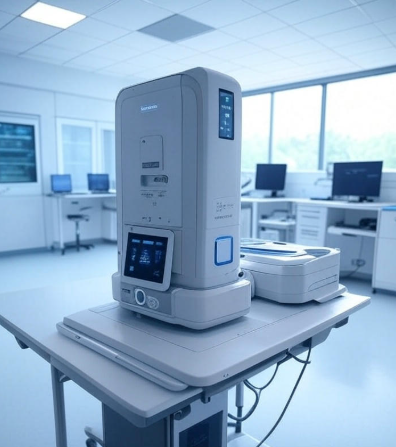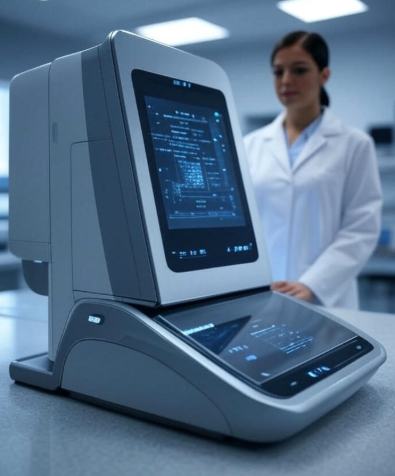Two weeks ago, the FDA made a decision that will fundamentally change how we screen for breast cancer. For the first time in medical history, they approved an AI system that can predict a woman’s risk of developing breast cancer years before traditional methods even have a chance.
I’ve been following this story since the early clinical trials, and I can tell you – this isn’t just another incremental improvement in medical technology. We’re looking at a complete paradigm shift in how we approach cancer prevention. Instead of waiting for tumors to grow large enough for doctors to spot, we’re now talking about identifying women at high risk when we can actually do something meaningful about it.
But here’s what’s really fascinating: the AI system doesn’t just match human radiologists – it consistently outperforms them. And it’s doing this by seeing patterns in mammogram images that are completely invisible to the human eye.
What This AI System Actually Does (And Why It’s Revolutionary)
The FDA-approved AI platform works by analyzing standard mammography images in ways that would be impossible for human radiologists. While a doctor looks at a mammogram and searches for obvious signs of cancer – lumps, unusual masses, or suspicious calcifications – the AI is examining thousands of subtle patterns across the entire breast tissue.
Think of it like this: imagine you’re looking at a forest and trying to predict which trees might fall in the next five years. A human expert might look for obvious signs – dead branches, visible rot, or trees leaning dangerously. But an AI system trained on thousands of forest images might notice that trees with a specific pattern of leaf density, combined with certain soil conditions and microscopic bark textures, have a 73% chance of falling within five years.
That’s essentially what’s happening with breast tissue. The AI has learned to recognize incredibly subtle patterns in breast density, tissue architecture, and other factors that correlate with future cancer development. It’s not looking for cancer that already exists – it’s predicting cancer that might develop.
The system assigns each woman a risk score that places her into specific risk categories. Women identified as high-risk can then be enrolled in enhanced screening programs, preventive treatments, or lifestyle interventions that can dramatically reduce their chances of developing cancer.
The Clinical Trial Results That Made the FDA Take Notice
The approval didn’t happen overnight. This AI system went through rigorous testing involving tens of thousands of women across multiple medical centers. The results were so compelling that they caught the attention of FDA reviewers who are notoriously cautious about approving new medical technologies.
In the largest clinical trial, the AI system was tested on mammograms from over 90,000 women who had been followed for at least five years. The researchers already knew which women had eventually developed breast cancer, so they could test whether the AI would have predicted those cases years earlier.
The results were striking. The AI correctly identified as high-risk about 70% of women who went on to develop breast cancer within five years. Just as importantly, it correctly classified as low-risk about 85% of women who remained cancer-free. This level of accuracy far exceeds current risk assessment tools that rely primarily on family history and other traditional risk factors.
But the most impressive finding was in the head-to-head comparison with human radiologists. When experienced breast imaging specialists were shown the same mammograms and asked to assess cancer risk, the AI system was significantly more accurate across all age groups and breast density categories.
One radiologist I spoke with described it as “humbling but exciting.” She told me, “I’ve been reading mammograms for 15 years, and this system is consistently seeing things that I miss. But instead of feeling threatened, I’m thrilled because it means we can help our patients in ways we never could before.”

Real Stories: How Early Risk Prediction Changes Lives
The abstract numbers are impressive, but the real impact becomes clear when you hear individual stories from the clinical trials.
Sarah Chen, a 42-year-old software engineer from Seattle, had what appeared to be a completely normal mammogram in 2019. Her radiologist saw nothing concerning, and based on traditional risk factors – no family history of breast cancer, no genetic mutations, healthy lifestyle – she was considered low-risk for developing cancer.
But the AI system flagged her as high-risk based on subtle patterns in her breast tissue. Following the clinical trial protocol, Sarah was enrolled in enhanced screening with MRI scans every six months instead of annual mammograms.
Eighteen months later, an MRI detected a small tumor that wouldn’t have been visible on a standard mammogram for at least another year or two. Because it was caught so early, Sarah needed only a lumpectomy and a short course of radiation therapy. No chemotherapy, no mastectomy, and a 98% chance of being cancer-free for life.
“The AI literally saved my life,” Sarah told me during a recent interview. “More importantly, it saved me from the kind of aggressive treatment that would have been necessary if we’d found the cancer later. I was back to normal activities within a month.”
Stories like Sarah’s are exactly why the FDA fast-tracked this approval. When you can shift cancer detection from late-stage emergency treatment to early-stage prevention, you’re not just improving survival rates – you’re fundamentally improving quality of life.
The Technology Behind the Breakthrough
Understanding how this AI system actually works helps explain why it’s so much more effective than traditional risk assessment methods.
The AI was trained on mammogram images from over 300,000 women, combined with detailed follow-up data about who developed cancer and when. This massive dataset allowed the system to learn patterns that are far too subtle and complex for human detection.
The technology uses what’s called a deep convolutional neural network – essentially a computer system modeled on how the human visual cortex processes images. But unlike human vision, which is optimized for survival tasks like recognizing faces and avoiding predators, this AI is specifically optimized for one thing: predicting breast cancer risk.
The system doesn’t just look at obvious features like breast density (though that’s included). It’s analyzing texture patterns, spatial relationships between different tissue types, subtle asymmetries between breasts, and hundreds of other features that don’t have names because humans have never been able to see them consistently.
What’s particularly impressive is that the AI performs well across different mammography equipment, different imaging protocols, and different patient populations. This consistency was crucial for FDA approval because medical AI systems often work well in the lab but fail when deployed in real-world clinical settings.
How This Changes Cancer Screening for Millions of Women
The immediate impact of this approval will be felt in breast imaging centers across the country. Radiologists will now have access to AI-powered risk assessment as part of routine mammogram interpretation.
For women classified as high-risk by the AI, the standard of care is likely to shift toward more intensive screening. This might include MRI scans in addition to mammograms, screening starting at younger ages, or screening at shorter intervals.
But the bigger change is philosophical. We’re moving from a reactive approach – waiting for cancer to develop and then treating it – to a predictive approach where we identify high-risk women and intervene before cancer has a chance to develop.
This shift has enormous implications for healthcare costs. Treating early-stage breast cancer typically costs $20,000-50,000. Treating advanced breast cancer can cost $200,000-500,000 or more. If AI-guided risk prediction can shift even 20% of cancers from late-stage to early-stage detection, the savings would be in the billions of dollars annually.
More importantly, the human cost savings are immeasurable. Women who avoid advanced cancer treatment keep their hair, their energy, their fertility, and in many cases, their lives.
The Controversies and Concerns Nobody’s Discussing
Not everyone is thrilled about AI-powered cancer risk prediction, and some of the concerns are worth taking seriously.
The biggest worry is what researchers call “overdiagnosis and overtreatment.” If the AI flags a woman as high-risk, she’ll likely undergo more intensive screening. This increased screening will inevitably detect some cancers that would never have caused problems – slow-growing tumors that would have remained dormant for decades.
Some of these women might undergo unnecessary treatments, including surgery, radiation, and chemotherapy, for cancers that never would have threatened their lives. This is already a problem with current screening methods, and AI-powered risk prediction could make it worse.
There are also equity concerns. The AI system was trained primarily on mammograms from women at large medical centers, which tend to serve more affluent, educated populations. Will it work as well for women who get their mammograms at community health centers? What about women of different ethnic backgrounds who might have different breast tissue patterns?
The FDA addressed some of these concerns by requiring the AI system to be tested across diverse populations, but critics argue that the testing wasn’t comprehensive enough.
Finally, there’s the question of insurance coverage. Enhanced screening for high-risk women can be expensive, and it’s not clear whether insurance companies will cover AI-guided screening recommendations. There’s a real risk that this technology could improve outcomes for wealthy women while leaving others behind.
What Doctors Are Really Thinking About AI
I’ve talked to dozens of radiologists, oncologists, and primary care physicians about this FDA approval, and their reactions are more nuanced than you might expect.
Most are genuinely excited about the potential to help their patients. One breast surgeon told me, “I went into medicine to prevent suffering, not just treat it after it happens. This technology finally gives us a real chance to get ahead of cancer instead of always chasing it.”
But there are also concerns about how AI will change their jobs. Radiologists, in particular, are grappling with the reality that AI systems are becoming better than humans at interpreting medical images. Some worry about becoming obsolete.
The more thoughtful physicians I spoke with see this as an opportunity to evolve their roles rather than a threat to their jobs. Instead of spending time on pattern recognition tasks that AI can do better, they can focus on patient communication, treatment planning, and the complex decision-making that still requires human judgment.
One radiologist summed it up perfectly: “The AI can tell me what’s in the image better than I can. But it can’t sit with a frightened patient and explain what that means for her life. That’s still my job, and it’s the part I care about most.”
The Next Wave of AI Medical Approvals
This breast cancer risk prediction approval is just the beginning. The FDA has several other AI medical systems under review, and the approval process is accelerating as regulators become more comfortable with the technology.
We’re likely to see AI systems for predicting heart disease risk, identifying early signs of dementia, and assessing cancer treatment responses within the next two years. Each of these approvals will build on the precedent set by this breast cancer system.
The long-term trajectory is clear: AI will become a standard part of medical practice, not as a replacement for physicians but as a powerful tool that makes them more effective.
What This Means for Every Woman
If you’re a woman over 40 who gets regular mammograms, this technology will likely be part of your healthcare within the next few years. Here’s what you should know:
The AI risk assessment will happen automatically as part of your routine mammogram – you won’t need to do anything different or pay extra fees. Your radiologist will receive both the standard mammogram interpretation and the AI risk score.
If you’re classified as high-risk, your doctor will discuss options for enhanced screening. This doesn’t mean you have cancer or will definitely develop cancer – it means you would benefit from more careful monitoring.
If you’re classified as low-risk, you can feel more confident that annual mammograms are sufficient screening for you.
Most importantly, remember that this is risk prediction, not diagnosis. The AI is helping doctors make better decisions about how to screen for cancer, but it’s not detecting cancer itself.
Looking Forward: The Preventive Medicine Revolution
The FDA’s approval of AI-powered breast cancer risk prediction represents more than just a new medical tool – it’s the beginning of a fundamental shift toward predictive, preventive medicine.
We’re moving into an era where AI systems will be able to analyze medical images, lab results, genetic data, and even information from wearable devices to predict disease risk years before symptoms appear. This will transform medicine from a field focused on treating disease to one focused on preventing it.
For patients, this means earlier interventions, less invasive treatments, and better outcomes. For the healthcare system, it means lower costs and more efficient resource allocation.
But perhaps most importantly, it means hope. For the first time in medical history, we have tools that can look into the future and give us a chance to change it. That’s not just a technological breakthrough – it’s a fundamental shift in our relationship with disease and mortality.
The AI doctor that can see five years into the future isn’t science fiction anymore. It’s sitting in imaging centers across the country, quietly analyzing mammograms and saving lives. And this is just the beginning.




